Are you wondering, “How Many Years Does It Take To Learn Guitar?” At guitarplayers.net, we understand that mastering the guitar is a journey, not a race, and the timeline varies for every aspiring guitarist. Whether you’re picking up a guitar for the first time or aiming to become a seasoned pro, we’ll break down the learning stages, provide expert tips to accelerate your progress, and offer resources to make your guitar playing dreams a reality. Delve into practice schedules, effective learning techniques, and the commitment required to achieve proficiency.
1. Key Takeaways: The Guitar Learning Timeline
Here’s a general timeline for learning guitar, but remember, individual progress may vary:
| Skill Level | Estimated Time |
|---|---|
| First Timers/Beginners | 1-6 months |
| Intermediate | 1-2 years |
| Professional | 2-3 years |
| Advanced | 5-6 years |
| Guitar Hero/Virtuoso | 10+ years |
2. How Long Does It Really Take to Learn the Guitar?
The timeframe for learning guitar isn’t set in stone. Your learning pace depends on numerous factors, including practice time, natural aptitude, and learning methods. Some guitarists might grasp the basics quickly, while others require more time and dedication. As a general benchmark, achieving expertise typically involves around 10,000 hours of practice.
According to research by Malcolm Gladwell, approximately 6.8 years of consistent 4-hour daily practice can transform a beginner into a guitar virtuoso. Let’s examine a more detailed breakdown of what you can achieve at each stage:
| Skill Level | Practice Time | Achievements |
|---|---|---|
| First Timers/Beginners | 1-6 months | Master the fundamentals: holding the guitar, basic open chords, and simple single-string melodies. Learn to play simple 4-chord songs with hammer-ons and pull-offs. |
| Intermediate | 1-2 years | Play more complex songs that incorporate riffs, blues progressions, and varied strumming patterns. Refine your technique through consistent practice. |
| Professional | 2-3 years | Develop a strong understanding of music theory, enabling you to improvise over songs and begin composing your own music. |
| Advanced | 5-6 years | Identify notes by ear, play complex compositions, and potentially monetize your skills through performances or teaching. |
| Guitar Hero/Virtuoso | 10+ years | Explore advanced guitar techniques, experiment with various genres, learn other instruments like the bass, and expand your overall musical expertise. |
3. What Are the Stages of Learning Guitar?
The journey from novice to virtuoso can be broken down into manageable steps. Here’s a structured approach to learning guitar:
Check out our Top 10 Guitar Riffs For Beginners on guitarplayers.net
3.1 Stage One: Mastering the Fundamentals
This initial stage is all about getting comfortable with the guitar.
- Holding the Guitar: Proper posture is crucial for preventing strain and improving your grip. Familiarize yourself with the instrument’s components, such as the fretboard, bridge, and tuning pegs.
- Basic Techniques: Practice basic strumming patterns and single-string picking exercises to develop hand-eye coordination.
- Tuning: Learn how to tune your guitar using a tuner or by ear. Understanding the pitch of each string is essential.
- Music Theory Introduction: Dive into basic music theory to understand notes, chord formations, keys, and intervals. This knowledge will significantly aid your progress.
- Single Note Exercises: Practice simple exercises to coordinate your left and right hands, improving dexterity and precision.
3.2 Stage Two: Learning Chord Progressions
At this stage, focus on mastering basic chords and developing a sense of rhythm.
- Open Chords: Memorize common open major and minor chords like E, A, G, C, and D. These form the foundation of countless songs.
- Rhythm Development: Practice strumming in time with a metronome to develop your rhythm and timing.
- Playing Songs: Start playing along with simple songs to practice chord transitions and improve your overall timing. Beginner-friendly songs include “Wonderwall” by Oasis and “Hey, Soul Sister” by Train.
3.3 Stage Three: Developing Technique
Enhance your technical skills with the following exercises:
- Alternate Picking: Train your picking hand to alternate between downstrokes and upstrokes for increased speed and precision.
- Scales: Learn the minor pentatonic scale, a versatile scale used in many genres. Focus on the first position to begin soloing and improvising.
- Fretboard Familiarity: Begin memorizing the notes on the fretboard, starting with the first five frets.
3.4 Stage Four: Advanced Playing Techniques
Start tackling more complex chords and improvisational playing:
- Barre Chords: Master barre chords to play chords in any key across the fretboard.
- Improvisation: Practice improvising over simple backing tracks using the scales you’ve learned.
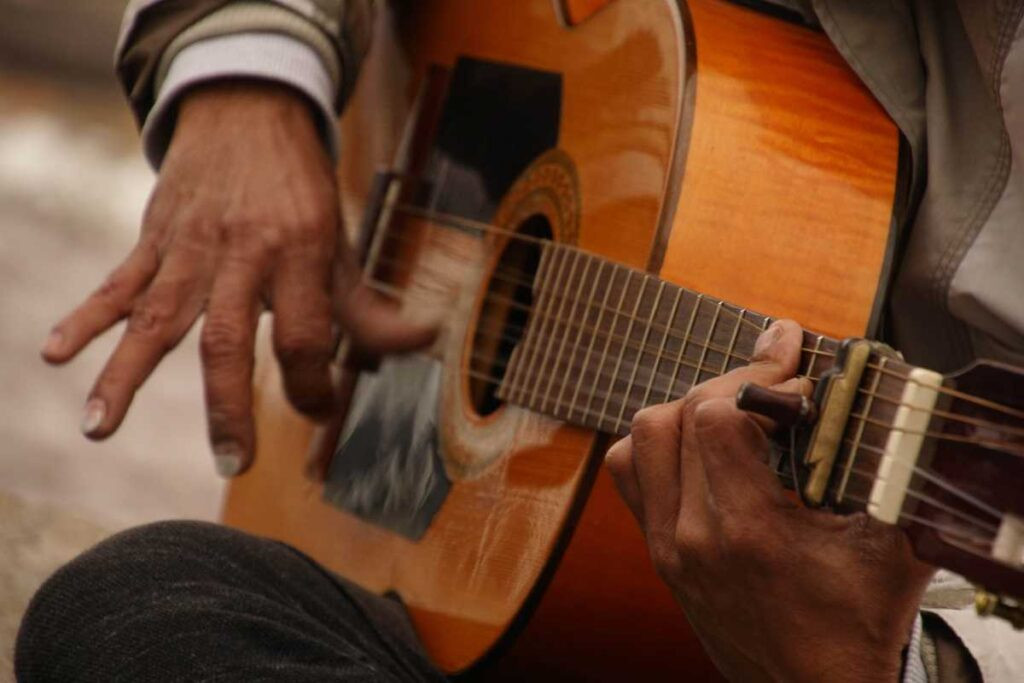 Developing Guitar Technique
Developing Guitar Technique
3.5 Stage Five: Deep Dive into Advanced Techniques
Continue expanding your technical skills:
- Pentatonic Scale Mastery: Master all positions of the pentatonic scale and learn major and minor diatonic scales.
- Seventh Chords and Extensions: Learn different types of seventh chords, including major, minor, dominant, and half-diminished chords.
- Expressive Techniques: Incorporate techniques like bends, vibrato, hammer-ons, pull-offs, and harmonics to add depth and emotion to your playing.
3.6 Stage Six: Mastery of Styles and Complexity
Refine your skills and add a professional touch:
- Modes and Modal Playing: Explore modes of the major scale to create diverse and interesting tones.
- Advanced Arpeggios and Chord Voicings: Utilize the CAGED system to unlock different chord voicings across the fretboard and master arpeggios for solos.
For further insights, check out online videos from fellow guitarists who share their learning experiences.
4. Follow These Tips to Accelerate Your Guitar Learning
To speed up your learning process and make it more efficient, consider these tips:
- Utilize Online Resources: Platforms like YouTube and Songsterr offer guitar tabs and playback features to aid in practice and learning.
- Start with the Basics: As a beginner, invest in a budget-friendly acoustic guitar and utilize free tuning apps like Guitar Tuna or Pano Tuner.
- Avoid Bad Habits: Pay attention to the posture and techniques of experienced guitarists to prevent developing poor habits.
- Begin with Any Song: Don’t worry about finding the “perfect” song to start with; the key is to start playing and gradually work your way up.
- Establish a Practice Schedule: Create a consistent practice schedule that fits your lifestyle, whether it’s a few hours a day or just a half-hour a week.
- Make Learning Fun: Focus on learning songs and riffs that you enjoy to stay motivated and avoid monotony.
Guitarplayers.net provides access to lessons, reviews, tabs and a community of guitar players.
5. Recommended Beginner Guitars
Choosing the right guitar can significantly impact your learning experience. Here are a few recommended beginner guitars:
5.1 Zager ZAD50 “OM”
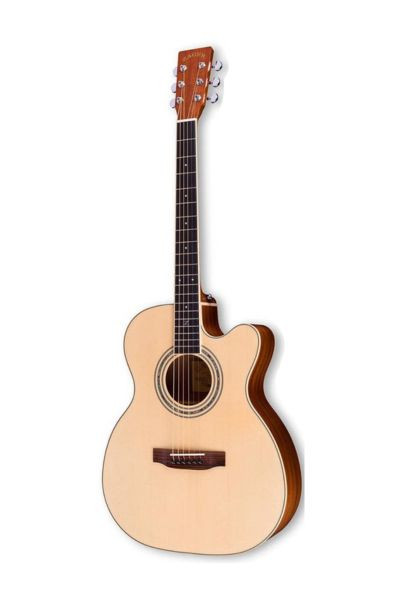 ZAD50CE Smaller “OM”
ZAD50CE Smaller “OM”
The Zager ZAD50 “OM” is a great beginner guitar. It has a solid wood construction with a hand-carved bracing system for improved rigidity. Its smaller size and custom string spacing make it comfortable for beginners, reducing finger strain.
Quick Spec List:
| Feature | Description |
|---|---|
| Body | Solid wood construction |
| Size | 15% smaller Orchestra Model |
| Neck | Adjustable truss rod, custom string spacing, soft touch fret design |
| Hardware | Grover tuning machines, hand-carved bone nut and saddle |
| Additional Features | Hand-laid abalone inlay rosette, hand-carved bracing system |
5.2 Zager Travel Guitar
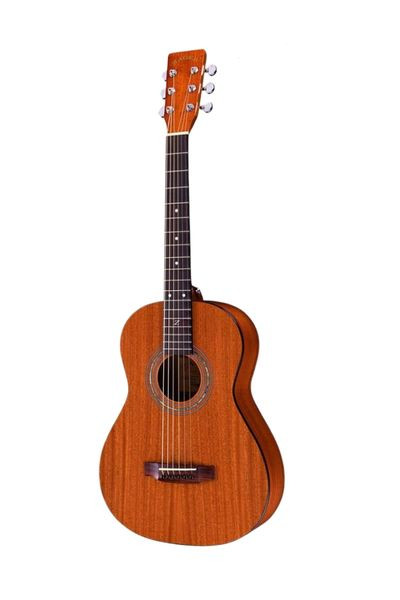 Zager Travel Acoustic-Electric
Zager Travel Acoustic-Electric
The Zager Travel Size is another excellent option for beginners. Its smaller size and solid mahogany construction make it comfortable and produce a rich tone that improves with age.
Quick Spec List:
| Feature | Description |
|---|---|
| Body | Solid mahogany construction |
| Neck | Slim neck design |
| Fingerboard | Custom design |
| Electronics | Fishman electronics with custom equalization |
| Additional Features | Automatic tuner, custom string spacing, soft touch fret design |
5.3 Yamaha FG800
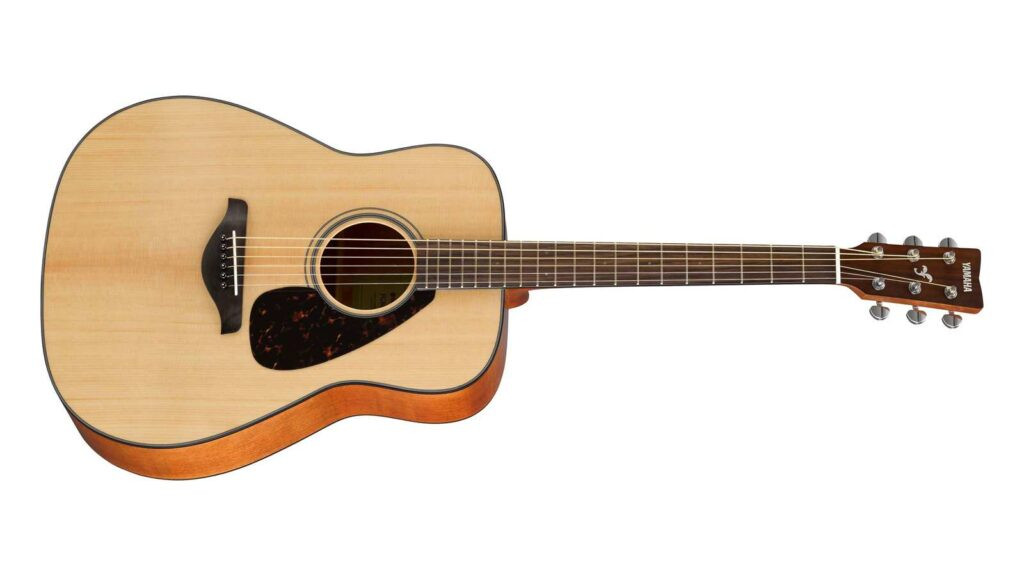 Yamaha FG800
Yamaha FG800
The Yamaha FG800 features a Sitka Spruce top with Nato/Okume back and sides, delivering a rich, full sound. Its shorter neck and comfortable action make it suitable for beginners.
Quick Spec List:
| Feature | Description |
|---|---|
| Body | Sitka Spruce top, Nato/Okume back/sides |
| Neck | Nato |
| Fingerboard | Walnut |
| Frets | 20 |
| Finish | Natural |
5.4 Ibanez PC12MHCE
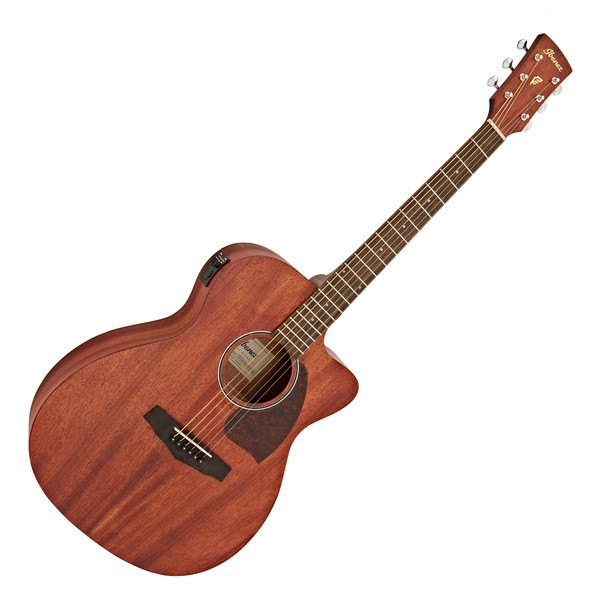 Ibanez PC12MHCE
Ibanez PC12MHCE
The Ibanez PC12MHCE is a great acoustic-electric option with an Okoume body and a sleek neck, making it comfortable for players with smaller hands. It features built-in electronics and a tuner.
Quick Spec List:
| Feature | Description |
|---|---|
| Body | Okoume top, Okoume back/sides |
| Neck | Okoume |
| Fingerboard | Laurel |
| Frets | 20 |
| Finish | Open pore |
6. Acoustic vs. Electric Guitar: Which Should You Start With?
While many guitarists recommend starting with an acoustic guitar, the choice ultimately depends on personal preference. Electric guitars offer some advantages for beginners, such as thinner necks and lighter strings, making it easier to fret chords. However, a quality electric guitar with reliable components can be more expensive than an acoustic.
Acoustic guitars require more hand strength due to thicker strings and wider necks, but mastering an acoustic guitar can make playing an electric guitar feel effortless. Adopting a “train hard, fight easy” approach can provide a solid foundation.
7. Online Communities: Learning Through Reddit
Explore Reddit threads for valuable insights and advice on the guitar learning process. Engaging with online communities can provide support and guidance as you progress.
8. Frequently Asked Questions
8.1 How Long Does It Take to Learn Guitar?
Typically, you can begin playing basic songs within a year of consistent practice. Some individuals may achieve this milestone in just a few weeks, depending on their passion and dedication.
8.2 Is It Okay to Learn Electric Guitar First?
Both electric and acoustic guitars offer unique advantages. Electric guitars have thinner strings, making them suitable for beginners. However, transitioning to acoustic guitar may present challenges due to the increased strength required to fret properly. Starting with an acoustic guitar can build a strong foundation.
9. Take Your Time and Enjoy the Process!
Learning guitar requires dedication and perseverance. If you have a natural aptitude for the instrument, you may progress quickly. If you encounter challenges, online resources like YouTube can provide valuable insights and motivation. Personal guitar lessons can also be beneficial, but with dedication, you can learn independently.
Ready to embark on your guitar-playing journey? Visit guitarplayers.net for lessons, reviews, tabs, and a supportive community of guitar enthusiasts in the USA! Discover the joy of learning guitar and unlock your musical potential. Address: 1140 Boylston Street, Boston, MA 02215, United States. Phone: +1 (617) 747-2261. Website: guitarplayers.net.
Alt: Close-up of hands playing chords on an acoustic guitar.
